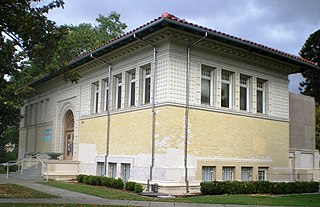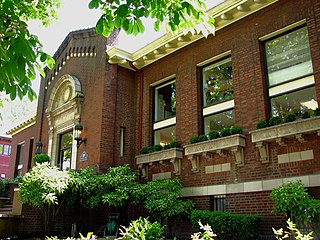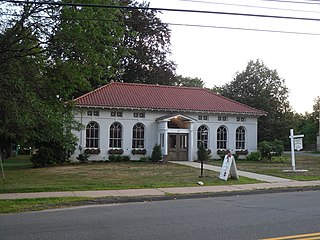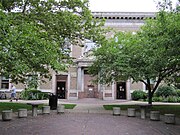
Vermont Square Branch Library is the oldest branch library in the Los Angeles Public Library system. Located about a mile southwest of the University of Southern California campus, in the Vermont Square district, it was built in 1913 with a grant from Andrew Carnegie. One of three surviving Carnegie libraries in Los Angeles, it has been designated a Historic-Cultural Monument and listed on the National Register of Historic Places.

The First Universalist Church is a historic Universalist Church building at 125 Highland Avenue in Somerville, Massachusetts. The Romanesque church building was built between 1916 and 1923 to a design by Ralph Adams Cram, and is the only example of his work in Somerville. The building was listed on the National Register of Historic Places in 1989. It is currently owned by the Highland Masonic Building Association, and is the home of King Solomon's Lodge AF & AM, the builders of the Bunker Hill Monument.

The West Somerville Branch Library is a historic library at 40 College Avenue in Somerville, Massachusetts, just outside Davis Square. It is an example of Classical Revival architecture, built in 1909 with funding support from Andrew Carnegie, and was the city's first branch library. It was listed on the National Register of Historic Places in 1989.

The Hopewell School is a historic school building located on Monroe Street in Taunton, Massachusetts. It was built in 1914, and designed by the Boston firm of Kilham & Hopkins in the Renaissance Revival style. The school replaced a previous school of the same name located around the corner on Bay Street in the Whittenton section of the city.

The Rockland Memorial Library is the public library of Rockland, Massachusetts. It is located at 382 Union Street, in a Carnegie-funded Classical Revival building, which was built in 1903 and is listed on the National Register of Historic Places. The library features several community oriented activities, such as raffles, book-release parties, and "Art in the Rotunda".

The Indian Orchard Branch Library is a historic branch library at 44 Oak Street in Springfield, Massachusetts. The Classic Revival building was constructed in 1909 to a design by John W. Donohue, and was the first permanent branch library building in the Springfield public library system; it was funded in part by a grant from Andrew Carnegie. The building was listed on the National Register of Historic Places in 1999; it continues to serve as a library as a branch of the Springfield City Library system.

The East Portland Branch, Public Library of Multnomah County housed part of the library system of Multnomah County, Oregon, from 1911 to 1967. Designed by architect A. E. Doyle, the structure was completed in 1911 in Portland at 1110 Southeast Alder Street in the city's central eastside. Funded in part by the Carnegie Foundation, the original building consisted of one floor and a daylight basement and included reading rooms for children and adults. The building had a red brick exterior, terra-cotta trim, and a roof of green Spanish tiles. Remodeled in 1956 and remodeled again prior to its sale in 1967, the one-story building, which had rooms 18 feet (5.5 m) high, became a two-story office building.

The Frances Perkins Branch Library, formerly known as the Greendale Branch Library, is a branch library in the public library system of Worcester, Massachusetts. It is located at 470 West Boylston Street, in an architecturally distinguished building, funded in part by Andrew Carnegie and built in 1913. The building was listed on the National Register of Historic Places in 1980.
The Mount Pleasant Library at 1600 Lamont Street, NW in Washington, DC is a branch of the District of Columbia Public Library System that opened in May 1925, and is the third oldest public library building still in use in Washington.

Edward Lippincott Tilton was an American architect, with a practice in New York City, where he was born. He specialized in the design of libraries, completing about one hundred in the U.S. and Canada, including many Carnegie libraries and structures for educational institutions.

The Springfield City Library is a public library system in Springfield, Massachusetts. The system includes ten branches across the city, with the Central branch located at 220 State Street, next to Merrick Park.

The Bayonne Public Library is the free public library of Bayonne, New Jersey. Incorporated in 1890, it serves a population of approximately 69,000.

The West End Library, now the Unionville Museum, is a historic library and museum building at 15 School Street in the Unionville village of Farmington, Connecticut. The Renaissance style building was designed by New York City architect Edward Tilton, and completed in 1917 with funding from Andrew Carnegie. The building was added to the National Register of Historic Places in 2000.

The Fletcher Free Library is the public library serving Burlington, Vermont. It is located at 235 College Street, in an architecturally distinguished Beaux-Arts building, constructed in 1902 with funding support from Andrew Carnegie. The building was listed on the National Register of Historic Places in 1976.

Greensburg Carnegie Public Library, also known as Greensburg City Hall, is a historic Carnegie library located at Greensburg, Decatur County, Indiana. It was built in 1904, and is a one-story, cruciform plan, tan brick building in the Classical Revival style. It is topped by a red terra cotta tiled gable roof and central drum and saucer dome. It features a projecting front portico supported by paired Ionic order columns. Its construction and furnishing was funded by a $15,000 grant provided by Andrew Carnegie.

The Sioux City Free Public Library is a historic building located in Sioux City, Iowa, United States. The library was located in a section of the Municipal Building, no longer extant, between 1892 and 1913. It had outgrown the space when the Library Board contacted Andrew Carnegie in 1910 about providing the funding for a new library building. Their request was initially turned down. They chose to work with New York City architect Edward L. Tilton, an architect preferred by Carnegie, in place of local architect William L. Steele who was working with the board previously. Local resident George Murphy donated the property for the new building. Meanwhile, Tilton designed the two-story brick Renaissance Revival building. On April 8, 1911, Carnegie approved the project and donated $75,000 for the building's construction. The new building was dedicated on March 6, 1913, and it is considered "an excellent early twentieth century example of the architectural development of library planning and design." It was Tilton's only building in Iowa.

Bolivar Public Library, also known as the Carnegie Library of Bolivar and Polk County Genealogical Society Library, is a historic Carnegie library located at Bolivar, Polk County, Missouri. It was built in 1915, and is a 1 1/2- to two-story, rectangular, brick building with Classical Revival style design elements. It has a flat roof and three bay front facade with an elaborate center entranceway and large side window bays. It features intact terra cotta and tooled limestone ornamentation. It was funded by an $8,000 Carnegie grant from the Carnegie Foundation. The property was listed on the National Register of Historic Places in 2003.

The Riverside Avenue Historic District is a 16.5 acres (6.7 ha) historic district in Downtown Spokane, Washington consisting of buildings constructed in the early 20th century, and was listed on the National Register of Historic Places in 1976. The listing includes 14 contributing properties, nine of which are considered primary and five are considered secondary.

The Southeast Neighborhood Library is a branch of the District of Columbia Public Library in the Capitol Hill neighborhood of Washington, D.C. It is located at 403 7th Street SE. Designed by architect Edward Lippincott Tilton in the neoclassical style, it opened in 1922 and is one of three Carnegie libraries in Washington. As of 2019, the city planned a $23.5 million renovation of the library starting in 2021. The building was listed on the National Register of Historic Places in 2021.

The Highland Park in Denver, Colorado, is a 7-acre (2.8 ha) park area bounded by Highland Park Place, Federal Blvd., and Fairview Place. It was developed as a park in 1907, and since 2013 it has included the Woodbury Branch Library. The park, with the library considered a contributing building, was listed on the National Register of Historic Places in 1986, as part of a Multiple Property Submission of historic resources of Denver's parks and parkways system.























